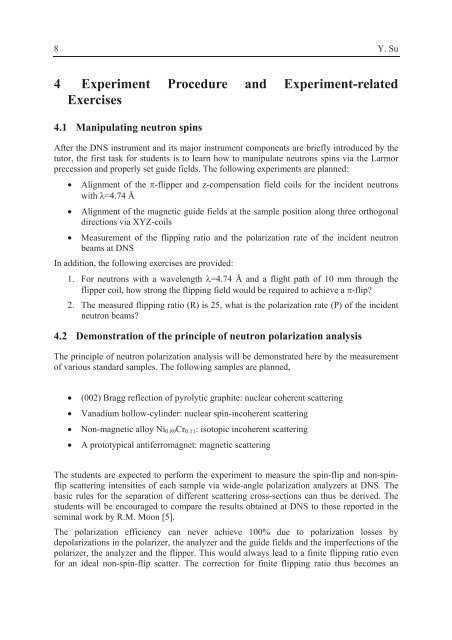Neutron Scattering - JUWEL - Forschungszentrum Jülich
Neutron Scattering - JUWEL - Forschungszentrum Jülich
Neutron Scattering - JUWEL - Forschungszentrum Jülich
You also want an ePaper? Increase the reach of your titles
YUMPU automatically turns print PDFs into web optimized ePapers that Google loves.
8 Y. Su<br />
4 Experiment Procedure and Experiment-related<br />
Exercises<br />
4.1 Manipulating neutron spins<br />
After the DNS instrument and its major instrument components are briefly introduced by the<br />
tutor, the first task for students is to learn how to manipulate neutrons spins via the Larmor<br />
precession and properly set guide fields. The following experiments are planned:<br />
� Alignment of the �-flipper and z-compensation field coils for the incident neutrons<br />
with �=4.74 Å<br />
� Alignment of the magnetic guide fields at the sample position along three orthogonal<br />
directions via XYZ-coils<br />
� Measurement of the flipping ratio and the polarization rate of the incident neutron<br />
beams at DNS<br />
In addition, the following exercises are provided:<br />
1. For neutrons with a wavelength �=4.74 Å and a flight path of 10 mm through the<br />
flipper coil, how strong the flipping field would be required to achieve a �-flip?<br />
2. The measured flipping ratio (R) is 25, what is the polarization rate (P) of the incident<br />
neutron beams?<br />
4.2 Demonstration of the principle of neutron polarization analysis<br />
The principle of neutron polarization analysis will be demonstrated here by the measurement<br />
of various standard samples. The following samples are planned,<br />
� (002) Bragg reflection of pyrolytic graphite: nuclear coherent scattering<br />
� Vanadium hollow-cylinder: nuclear spin-incoherent scattering<br />
� Non-magnetic alloy Ni0.89Cr0.11: isotopic incoherent scattering<br />
� A prototypical antiferromagnet: magnetic scattering<br />
The students are expected to perform the experiment to measure the spin-flip and non-spinflip<br />
scattering intensities of each sample via wide-angle polarization analyzers at DNS. The<br />
basic rules for the separation of different scattering cross-sections can thus be derived. The<br />
students will be encouraged to compare the results obtained at DNS to those reported in the<br />
seminal work by R.M. Moon [5].<br />
The polarization efficiency can never achieve 100% due to polarization losses by<br />
depolarizations in the polarizer, the analyzer and the guide fields and the imperfections of the<br />
polarizer, the analyzer and the flipper. This would always lead to a finite flipping ratio even<br />
for an ideal non-spin-flip scatter. The correction for finite flipping ratio thus becomes an

















